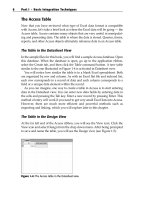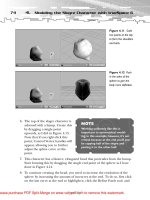Tài liệu John Wiley And Sons Electronics For Dummies Ebook P2 doc
Bạn đang xem bản rút gọn của tài liệu. Xem và tải ngay bản đầy đủ của tài liệu tại đây (703.56 KB, 20 trang )
plant, the direction in which the electrons flow changes 120 times a second,
making a complete turnaround 60 times a second. This change in electron
flow is called alternating current, or AC.
When the change in electron flow makes a complete loop, it’s called a cycle.
The number of cycles per second in alternating current is measured in Hertz,
abbreviated Hz. The example of a cycle in the previous paragraph is based on
the fact that the United States uses a 60 Hertz standard frequency; some
other countries use 50 Hertz as a standard, which means that the electrons
change direction 100 times a second.
Electricity generated at a dam uses water to turn a coil of wire inside a huge
magnet. One of the properties of magnets and wires is that when you move a
wire near a magnet, a flow of electrons is induced in the wire. First, the magnet
causes the electrons to flow in one direction, and then, when the wire loop
rotates 180 degrees, the magnet pulls the electrons in the other direction. This
rotation creates alternating current.
Just plugging a cord into a wall outlet sounds easy enough, but you need
direct current for most projects, rather than alternating current. If you use
wall outlets to supply electricity for your project, you have to convert the
electricity from AC to DC. You can do this conversion with something called
a power supply. For an example of a power supply, think of the charger that
you use for your cell phone; this little device essentially converts AC power
into DC power that the battery uses to charge itself back up. You can find out
more about power supplies in Chapter 3.
Safety, safety, safety. It’s an important issue for you to consider when decid-
ing whether to use the AC electricity that you get from wall outlets. Using the
electricity from a battery is like petting a house cat. Using the electricity from
wall outlets is more like cozying up to a hungry lion. With a cute tabby, you
may get your hand scratched; with the king of the jungle, you may be eaten
alive. If you think that you need to use electricity from a wall outlet for a pro-
ject, make sure that you know what you’re doing first. See Chapter 2 for spe-
cific advice about safety.
14
Part I: Getting Started in Electronics
Which came first, voltage or current?
Batteries produce a voltage that drives an elec-
tric current. Generators at dams drive a current
that produces a voltage. Which comes first?
This is like asking yourself the well-known ques-
tion about the chicken and egg. Voltage, cur-
rents, and conductors all work together. If there
is a voltage applied across a conductor, electric
current flows. If you have an electric current
flowing through a conductor, there will be volt-
age across the conductor. Bottom line: Don’t
worry about which comes first.
TEAM LinG - Live, Informative, Non-cost and Genuine !
Solar cells
Solar cells are a form of semiconductor. Like batteries, solar cells have wires
attached to two terminals. Shining light on a solar cell causes an electric cur-
rent to flow. (This reaction to light is a property of semiconductors and is
discussed in the sidebar “Getting fancy with semiconductors,” later in this
chapter.) The current is then conducted through wires to devices, such as a
calculator or a garden light beside the pathway to your front door.
Using a calculator containing a solar cell, you can demonstrate that the calcu-
lator depends on the light shining on the solar cell for its power. Turn the
calculator on and punch some numbers into the screen (choose a nice big
number, like your income tax). Now, use your thumb to cover the solar cell.
(The solar cell is probably near the top of the calculator in a rectangular
area with a clear plastic cover.) After you’ve covered up the solar cell for a
moment, the numbers fade away. Take your thumb off the solar cell, and the
numbers reappear. Things powered by solar cells need light to work.
Where Do Electrical Components Fit In?
Electrical components are parts you use in electronics projects. Simple enough,
right? You use some electrical components to control the flow of electricity,
such as a dimmer switch that adjusts the brightness of a light. Electricity
simply powers other electrical components, such as speakers blasting out
sound. Still other electronic components, called sensors, detect something
(such as light or heat) and then generate a current to do something in
response, such as set off an alarm.
In this section, you meet some basic electrical components. Chapters 4 and 5
provide much more detail about components.
15
Chapter 1: From Electrons to Electronics
A simple choice: AC or DC
What difference does it make to you if you use
alternating or direct current? A lot of difference!
AC costs less to generate and send over trans-
mission lines than DC. That’s why you use AC for
many household electricity needs, such as
powering light bulbs and heaters.
However, DC is simpler to use for the pro-
jects discussed in this book (and many other
electronics applications). It’s just plain harder to
control AC current because you don’t know
which way it’s headed at any point in time. It’s
the difference between controlling traffic on a
two-way, six-lane highway, and controlling traf-
fic on a one-lane, one-way street. So, most of
the circuits you read about in this book use
direct current.
TEAM LinG - Live, Informative, Non-cost and Genuine !
Controlling electricity
Electrical components, or parts, can control electricity. For example, a switch
connects a light bulb to electric current. To disconnect the light bulb and
make it go dark, the switch simply makes a break in the circuit.
Some other parts that control electricity are resistors, capacitors, diodes,
and transistors. You can find more information on these parts in Chapter 4.
Controlling electricity even better (ICs)
Integrated circuits, or ICs, are components that contain a whole bunch of
miniature components (such as resistors, transistors, or diodes, which you
hear about in Chapter 4) in one device that may not be much bigger than an
individual component. Because each IC contains many components, one little
IC can do the same job as several individual parts.
16
Part I: Getting Started in Electronics
Getting fancy with semiconductors
Transistors, diodes, LEDs, integrated circuits, and
many other electronic devices use a semicon-
ductor instead of a conductor. A semiconductor
is a material, such as silicon, that has some of the
properties of both conductors and insulators.
Silicon is pretty cool stuff. In fact, they’ve named
a whole valley in California after it. In its pure
state, silicon conducts an electric current poorly.
But if you add contaminates, such as boron or
phosphorus, to the silicon, it conducts. When you
add phosphorus, silicon becomes an “n”-type
semiconductor. When you add boron, silicon
becomes a “p”-type semiconductor. An “n”-type
semiconductor has more electrons than a pure
semiconductor and a “p”-type semiconductor
has fewer electrons than a pure semiconductor.
When the regions containing boron and phos-
phorus are next to each other in silicon, you have
a “pn” junction. Current flows in only one direc-
tion across a “pn” junction. Diodes, components
that can convert AC to DC by limiting the flow of
current to one direction, are an example of a
component that contains a “pn” junction.
A “pn” junction generates an electric current
when exposed to light; this property is used when
building solar cells. On the other hand, when you
run an electric current through a “pn” junction, it
emits light, as light-emitting diodes (LEDs) do.
Transistors use junctions in which three adja-
cent areas have contaminants added. For
example, one region with phosphorus, one with
boron, and another with phosphorus result in an
“npn” junction. In a transistor, you apply a cur-
rent to the middle of the three regions (the
base), allowing a current to flow.
Most electronics projects you work on use com-
ponents such as transistors, diodes, and inte-
grated circuits, and these are made with
semiconductors. It’s semiconductors that have
made possible much tinier electronic gadgets
(like handheld computers and palm-sized radios).
TEAM LinG - Live, Informative, Non-cost and Genuine !
An audio amplifier is one example of an IC. You can use audio amps to increase
the power of an audio signal. For example, if you have a microphone, its small
output signal is fed through an audio amplifier to make a strong enough signal
to power a speaker.
Another type of IC used in electronics projects is a microcontroller, a type of
integrated circuit that you can actually program to control cool gadgets like
robots. We discuss microcontrollers in more detail in Chapter 13.
Sensing with sensors
Certain electrical components generate a current when you expose them to
light or sound. You can use the current generated, together with a few of the
components listed in the previous sections that control electricity, to turn on
or off electronic devices, such as light bulbs or speakers.
Motion detectors, light sensors, microphones, and temperature sensors all
generate an electrical signal in response to a stimulus (motion, light, sound,
or temperature, respectively). These signals can then be used to turn other
things on or off. A high signal level might turn something on and a low signal
level turn something off. For example, when a salesperson walks up to your
house, a motion detector can turn on a light (or better yet, sound a general
alarm).
These signals take different forms, depending on the component supplying
them. For example, a microphone supplies an AC signal, and a temperature
sensor supplies a DC signal.
Figure 1-1 shows diagrams of a few signals that you run into often when work-
ing with electronics. These signals include
ߜ + 5 Volt DC signal: A high input.
ߜ 0 volt DC signal: A low input.
ߜ 0 to 5 volt DC square wave: The output of an oscillator (a device that
cycles between high and low voltage); if you use this signal as input to a
light bulb, it causes the light to blink on and off.
ߜ - 5 volt to + 5 volt AC sine wave: A signal, such as from a microphone,
that generates alternating current that a device, such as an amplifier,
uses as input. A microphone generates the waveform in Figure 1-1 when
it receives the sound produced by a tuning fork. Notice in Figure 1-1 that
the transitions from +5 volts to -5 volts are gradual for the sine wave and
more abrupt in the square wave.
You can find out more about various types of sensors in Chapter 5.
17
Chapter 1: From Electrons to Electronics
TEAM LinG - Live, Informative, Non-cost and Genuine !
Powering up
Electricity can power electrical components to produce light, heat, sound,
motion, and more. For example, an electric current supplied to a DC motor
causes the shaft of the motor to rotate, along with anything you’ve attached
to that shaft.
You can power speakers, light bulbs, LEDs, and motors with electricity. If you
want to read more about these types of components, check out Chapters 4
and 5.
+ 5 VOLTS
0 VOLTS
+ 5 VOLT DC
SIGNAL
0 VOLT DC
SIGNAL
0 TO 5 VOLTS DC SQUARE WAVE
-5 TO + 5 VOLT AC SINE WAVE
+ 5 VOLTS
0 VOLTS
0 VOLTS
+ 5 VOLTS
- 5 VOLTS
Figure 1-1:
Just a few
examples of
input
signals.
18
Part I: Getting Started in Electronics
TEAM LinG - Live, Informative, Non-cost and Genuine !
How Electricity Becomes Electronics
When you need to use electricity to make something work, such as a boom
box, you’ve entered the world of electronic gadgets. No doubt you’re eager to
start making your own electronic gadgets. We cover the basics of how elec-
tronics and gadgets interact in the following sections.
Creating a simple circuit
Take a battery, a resistor, an LED, and some wires, put them together, and you
have a simple electronic circuit. That’s all an electronic circuit is — wires con-
necting components so that a current can flow through the components and
back to the source.
Figure 1-2 shows a simple circuit. You place the parts in this circuit (also
called components) on something called a breadboard and connect those
parts with wires. If you’ve ever played with Mr. Potato Head, you understand
the principle of a breadboard. You stick things in the potato (ears, a hat,
eyes, and so on) to form a potato person. In the same way, a breadboard has
slots for you to insert electronic components to build a sample circuit. If
you’re really happy with what you’ve created, you can then use that design
to get a printed circuit board made. (See Chapter 11 for more information on
building circuits on breadboards.)
Figure 1-2:
A collection
of parts is
assembled
into a
circuit.
19
Chapter 1: From Electrons to Electronics
TEAM LinG - Live, Informative, Non-cost and Genuine !
Figure 1-2 shows wires connected to both terminals of the battery in the cir-
cuit. This connection allows the current to flow from the battery, through the
LED and other components, and back to the battery to complete the circuit.
You can also complete the circuit by connecting parts of the circuit to the
metal chassis of a gadget, such as the metal housing of a stereo. We call this
connection a ground because it is used as the reference for all voltages in the
circuit. Ground may or may not be connected to the actual earth, but it is
always the reference from which you measure all other voltages. We discuss
grounding in detail in Chapter 6.
You can represent a circuit as a schematic. A schematic is just a drawing
showing how components are connected together by wires. Check out the
schematic for the circuit in Figure 1-2 in Figure 1-3. You can go to Chapter 6
for more on schematics.
Deciding what to build
If you’re itching to build a simple circuit to try out your skills, you can find sev-
eral circuits in Chapter 14. For example, you can create a breadboard circuit
that sounds an alarm when someone turns on a light in your room. Building
these projects is a fun way to get familiar with how to put together a circuit.
(But don’t jump right into projects if you’re a beginner — not until you’ve read
through a few chapters in this book, especially Chapter 2 about safety.)
After you put together some of the breadboard projects in Chapter 11 and
build up your basic skills, you can move on to the projects in Chapter 15,
such as constructing a small robot. These projects take more time, but they
can result in some truly neat gadgets.
After you’ve developed your skills building some of the projects in this
book, you can go farther. One place to get additional ideas is on the
Internet. Two sites we recommend are
discovercircuits.com/
and
www.
electronics-lab.com
.
+
−
Figure 1-3:
Can you
decipher
this
schematic
of the circuit
shown in
Figure 1-2?
20
Part I: Getting Started in Electronics
TEAM LinG - Live, Informative, Non-cost and Genuine !
Along the Way You Get
to Play with Tools
One of the best things about building electronics projects is that you get to
tinker with tools and parts and see what you can make from them. You use
some tools to put the circuits together and some tools to check out how the
circuits you build are working.
Tools to build things
You’re probably glad to hear that you don’t need that many tools to get
started. You just need a wire cutter, needle-noise pliers, a wire stripper, and
a few screwdrivers to get started with the projects covered in Chapter 14.
If you design a circuit that you want to make more permanent, you need to
get a soldering pencil (also called a soldering iron) to attach the elements of
a circuit together. We cover choosing a soldering pencil in Chapter 8.
As you work with projects, no doubt other miscellaneous tools pop up that
you may want to get your hands on. You can use a magnet to retrieve screws
and other tiny things that you inevitably drop in hard-to-reach places, for
example. Check out Chapter 3 for details on outfitting your workbench.
Tools to measure things
When building or troubleshooting a circuit, you need to make measurements
to check that parts are working the way they should and that you designed
and built the circuit correctly. Tools that you can use to measure things
include a multimeter, an oscilloscope, and a logic probe. Chapters 9 and 10
cover the use of these tools.
We’ll take a moment to briefly tell you what you can use a multimeter for
because it’s the measuring tool that you buy first and possibly the only one
that you ever need.
Say you build a circuit, and you’ve just turned it on. What if the circuit doesn’t
work? With a multimeter, you can find out which part of the circuit is causing
the problem. You can measure voltage, resistance, and current at different
points on the circuit. For example, if there are 5 volts at one location on the
circuit and further along at another location your voltage suddenly drops to
0 volts for no logical reason you can make a good guess that your problem lies
between those two locations. You can then check (after the power is discon-
nected, please!) for loose wires or damaged parts between those two locations.
21
Chapter 1: From Electrons to Electronics
TEAM LinG - Live, Informative, Non-cost and Genuine !









